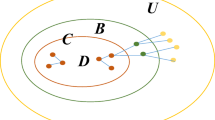Abstract
The local community detection (LCD) method can discover the local community structure in which the seed node is located. Compared with global community detection, local community detection is characterized by its low cost and high efficiency. However, most existing LCD methods only return a non-overlapping community. Individuals in the real world may participate in multiple communities, which can only be discovered by using overlapping local community detection methods. In this study, an overlapping local community detection algorithm based on modularity and node transitivity. First, the scope and structure information of the overlapping communities are obtained according to the node transitivity. Second, NMF is used to obtain the number of overlapping communities. Finally, the local modularity density based on edge weights is used to refine the detected local communities. The experimental results validate the high performance of our method to the other method in comparison.
Access this chapter
Tax calculation will be finalised at checkout
Purchases are for personal use only
Similar content being viewed by others
References
Gregory, S.F.: Finding overlapping communities in networks by label propagation. New J. Phys. 12(10), 103018 (2010)
Clauset, A.F.: Finding local community structure in networks. Phys. Rev. E 72(2), 026132 (2005)
Chen, Q.F., Wu, T.S., Fang, M.S.: Detecting local community structures in complex networks based on local degree central nodes. Phys. A: Stat. Mech. Appl. 392(3), 529–537 (2013)
Luo, F.F., Wang, J.S., Promislow, E.T.: Exploring local community structures in large networks. In: 2006 IEEE/WIC/ACM International Conference on Web Intelligence, pp. 233–239. IEEE, Hong Kong (2006)
Luo, W.F., Zhang, D.S., Jiang, H.T.: Local community detection with the dynamic membership function. IEEE Trans. Fuzzy Syst. 26(5), 3136–3150 (2018)
Meng, T.F., Cai, L.S., He, T.T.: Local higher-order community detection based on fuzzy membership functions. IEEE Access 7, 128510–128525 (2019)
Luo, W.F., Lu, N.S., Ni, L.T.: Local community detection by the nearest nodes with greater centrality. Inf. Sci. 517, 377–392 (2020)
Jian, Z.F., Ma, H.S., Huang, J.T.: CLOSE: local community detection by LOcal structure expansion in a complex network. In: 2019 International Conference on Technologies and Applications of Artificial Intelligence, pp. 1–6. IEEE, Taiwan (2019)
He, K.F., Shi, P.S., Bindel, D.T.: Krylov subspace approximation for local community detection in large networks. ACM Trans. Knowl. Discov. Data (TKDD) 13(5), 1–30 (2019)
Li, X.F., Xu, G.S., Lian, W.T.: Multi-layer network local community detection based on influence relation. IEEE Access 7, 89051–89062 (2019)
Hollocou, A.F., Bonald, T.S., Lelarge, M.T.: Multiple local community detection. ACM SIGMETRICS Perform. Eval. Rev. 45(3), 76–83 (2018)
Ni, L.F., Luo, W.S., Zhu, W.T.: Local overlapping community detection. ACM Trans. Knowl. Discov. Data 14(1), 1–25 (2019)
Kamuhanda, D.F., He, K.S.: A nonnegative matrix factorization approach for multiple local community detection. In: 2018 IEEE/ACM International Conference on Advances in Social Networks Analysis and Mining, pp. 642–649. IEEE, Barcelona (2018)
Binesh, N.F., Rezghi, M.S.: Fuzzy clustering in community detection based on nonnegative matrix factorization with two novel evaluation criteria. Appl. Soft Comput. 69, 689–703 (2018)
Liu, X.F., Wang, W.S., He, D.T.: Semi-supervised community detection based on non-negative matrix factorization with node popularity. Inf. Sci. 381, 304–321 (2017)
Dohleman, B.F.: Exploratory social network analysis with Pajek. Psychometrika 71(3), 605 (2018)
Zachary, W.F.: An information flow model for conflict and fission in small groups. J. Anthropol. Res. 33(4), 452–473 (1977)
Lusseau, D.F., Schneider, K.S., Boisseau, O.T.: The bottlenose dolphin community of Doubtful Sound features a large proportion of long-lasting associations. Behav. Ecol. Sociobiol. 54(4), 396–405 (2003)
Political books network. http://www.orgnet.com. Accessed 28 June 2020
Rossi, R.F., Ahmed, N.S.: The network data repository with interactive graph analytics and visualization. In: Twenty-Ninth AAAI Conference on Artificial Intelligence, pp. 4292–4293. AAAI, Texas (2015)
Girvan, M.F., Newman, M.S.: Community structure in social and biological networks. Proc. Natl. Acad. Sci. 99(12), 7821–7826 (2002)
Yin, H.F., Benson, A.S., Leskovec, J.T.: Local higher-order graph clustering. In: Proceedings of the 23rd ACM SIGKDD International Conference on Knowledge Discovery and Data Mining, pp. 555–564. ACM, Halifax (2017)
Yang, J.F., Leskovec, J.S.: Defining and evaluating network communities based on ground-truth. Knowl. Inf. Syst. 42(1), 181–213 (2015)
Lancichinetti, A.F., Fortunato, S.S., Radicchi, F.T.: Benchmark graphs for testing community detection algorithms. Phys. Rev. E 78(4), 046110 (2008)
Schütze, H.F., Manning, C.S., Raghavan, P.T.: Introduction to Information Retrieval. Cambridge University Press, Cambridge (2008)
Acknowledgements
This work is partly supported by the National Natural Science Foundation of China under Grant No. 61672159, No. 61672158, No. 62002063 and No. 61300104, the Fujian Collaborative Innovation Center for Big Data Applications in Governments, the Fujian Industry-Academy Cooperation Project under Grant No. 2017H6008 and No. 2018H6010, the Natural Science Foundation of Fujian Province under Grant No. 2019J01835 and No.2020J01230054, and Haixi Government Big Data Application Cooperative Innovation Center.
Author information
Authors and Affiliations
Corresponding author
Editor information
Editors and Affiliations
Rights and permissions
Copyright information
© 2021 Springer Nature Singapore Pte Ltd.
About this paper
Cite this paper
Huang, X., Wu, L., Guo, K. (2021). An Overlapping Local Community Detection Algorithm Based on Node Transitivity and Modularity Density. In: Sun, Y., Liu, D., Liao, H., Fan, H., Gao, L. (eds) Computer Supported Cooperative Work and Social Computing. ChineseCSCW 2020. Communications in Computer and Information Science, vol 1330. Springer, Singapore. https://doi.org/10.1007/978-981-16-2540-4_35
Download citation
DOI: https://doi.org/10.1007/978-981-16-2540-4_35
Published:
Publisher Name: Springer, Singapore
Print ISBN: 978-981-16-2539-8
Online ISBN: 978-981-16-2540-4
eBook Packages: Computer ScienceComputer Science (R0)





